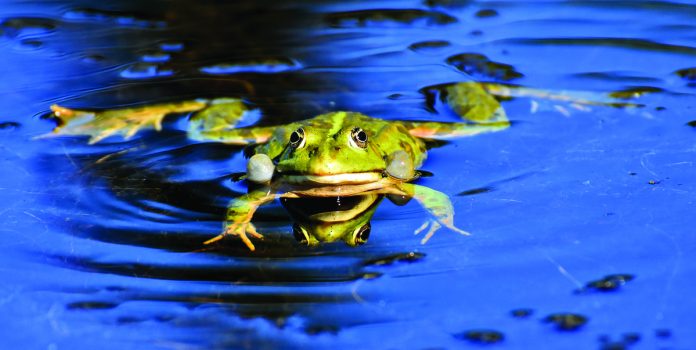Drive slowly by a farm pond, a lake or a wetland on a warm summer evening, and you’re likely to hear two distinctive voices.
A deep, booming, “Jug-o’-rummm!” betrays a male bullfrog. On a lake, the sound can travel up to a mile across open water.
As darkness falls, dozens of bullfrog voices might punctuate the stillness of the night.
A sound weirdly reminiscent of a loose banjo string, on the other hand, is the love song of an amorous male green frog.
Though similar in appearance, bullfrogs can reach a length of seven inches; green frogs top out at about four inches (size does not include the extended rear legs).
Both male and female bullfrogs vocalize, but the “jug-o’-rum” mating song of the male is the louder and more familiar. Other calls signal territory ownership, warning and distress.
Bullfrogs emerge in early spring, but delay breeding until late May. Their deep booming voice announces the arrival of summer.
Any quiet body of water surrounded by dense vegetation is likely to shelter bullfrogs. Farm ponds and lakes ringed with cattails and water lilies are bullfrog heaven. Males sing to attract females to their territories.
Males sing “station” along the bank that they defend and return to night after night. Mating occurs in the water.
The male pounces on any female that ventures near and grabs her tightly. He fertilizes the eggs (thousands of them) as she releases them. The embrace, which is typical of frogs and toads, is called amplexus.
The female simply releases the eggs on the surface of the water around pieces of aquatic vegetation.
Eggs hatch in three to five days. After spawning in late May or early June, bullfrogs sometimes repeat the process in late July.
Tadpoles reach a length of one inch by the end of their first summer. Before transforming into adults, however, they grow extraordinarily large. Bullfrog tadpoles often reach lengths of six inches or more before transforming into frogs after 12 to 14 months as tadpoles.
Young bullfrogs then require another two years to reach sexual maturity. This means bullfrogs can be three to four years old before they breed.
Unlike most frogs, which eat small insects, spiders and earthworms, bullfrogs attack any live animal smaller than themselves that they can swallow.
Biologists have found all sorts of insects, fish, crayfish, mice, bats, small turtles, lizards, ducklings, smaller frogs (including smaller bullfrogs) and even scorpions and hatchling alligators in bullfrog stomachs.
Using a sit-and-wait hunting technique, bullfrogs can remain motionless for long stretches of time yet remain alert to movement.
If danger threatens, it’s hop, splash and off to the safety of deeper water.
But if a crayfish, minnow or snake gets too close, it’s mealtime.
And beware if you have bullfrogs living in a small backyard pond. They do not hesitate to eat small birds, even hummingbirds, that stop by for a drink or a bath. Google “bullfrogs eating birds” online for graphic videos.
Green frogs are essentially a smaller version of bullfrogs. In some places, they are the most common frog encountered.
Walk along a farm pond, a roadside ditch, or even a deep puddle, and these are the frogs that startle as they leap from the water’s edge into deeper water. Often, they squeak loudly as they jump.
Of course, frogs make great meals for a variety of predators. Water snakes, snapping turtles, raccoons, mink, otters, alligators, owls and herons are just a few of the predators that eat them.
Humans are also on the list. Bullfrog legs are tasty and often found at restaurant buffets. (They taste like chicken; wink, wink)
In fact, our taste for frog legs allowed bullfrogs to become an ecological disaster in places where they’ve been introduced for commercial harvest.
Native to the eastern U.S., bullfrogs were imported to California in 1898 to meet consumer demand. Since then, they’ve been released in Asia, Europe and South America.
In the absence of natural predators, bullfrogs thrive and wreak havoc on wetland ecosystems.













